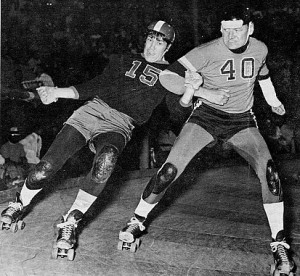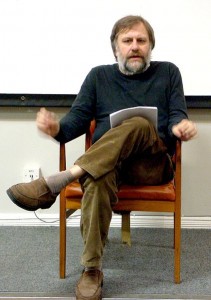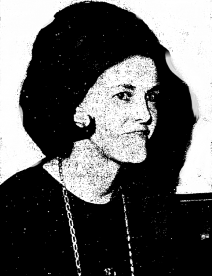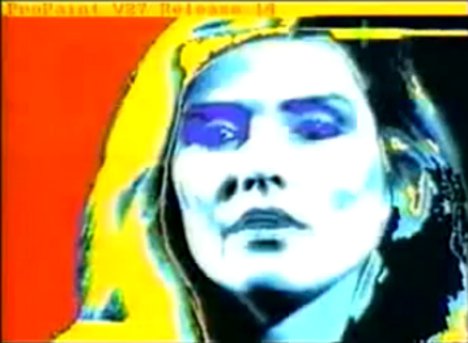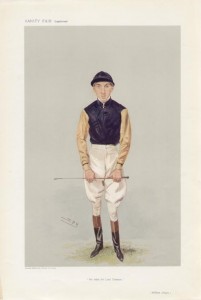George Carlin, our best stand-up ever, cutting through this era’s idiotic jargon. I wish he was still with us, dissecting the world as it simultaneously gets smarter and dumber, closer together and further apart.
You are currently browsing the archive for the Videos category.
Tags: George Carlin
From a fun 1974 People article about the wedded life of roller derby royalty, “Dynamite” Mike Gammon and Judi McGuire, who married in their mid-teens and separated a few years after this piece was published:
Mike Gammon and his wife Judi McGuire are leading practitioners of one of the world’s most demeaning professions. They are stars of the New York Chiefs of the roller derby which is closer to third-rung Minsky or carny than organized sport. Their six-game-a-week 51-week season is an escape-less loop of one-night stands, in smoggy arenas, with nothing in between but smelly buses, crummy motels and junk food. The circuit is a demanding test of their family’s ability to stay intact. They get to see their 12-year-old daughter Sharilee only about once every six weeks. And the Gammons put up with all these indignities to perform before lunatic crowds, bellowing the foulest of four-letter abuse, pelting them with old sneakers and plastic cups full of beer, and generally carrying on in a manner that makes ice-hockey rinks seem, by comparison, like Wimbledon.
For nearly 16 years now, Mike, 31, Judi, 33, and their marriage have toughed out their little hell on roller skates with seemingly minimal damage. They look clean-cut enough to play a TV situation comedy. Physically they are not noticeably marked, because those skirmishes that bring out the animal in the audience are often artfully faked. (“The winning and losing team is predetermined before the match, but there can be a lot of jammings and other free-lance rough stuff along the way,” says one player.) Why do the Gammons put up with it all? “If you want a paycheck, you skate,” Mike explains. “We don’t like it much, but when you’re hungry, you’re hungry.” And because he dropped out of school after the eighth grade—it is one of the few ways to pull in $45,000. That is between them, though, and includes supplements for extra work: Mike is one of the roustabouts who install the track pre-game, and Judi stitches up the clawed and tattered uniforms during the endless bus trips.
Judi sometimes regrets that having started in the derby in their teens, “we had almost no time to grow up.” But she concludes stoically, “It’s been a good life, because we’ve been together nearly 24 hours a day, and that’s made us stronger.”•
__________________________________
“This is roller derby…they call it America’s fastest growing sport…that it is…15 million people watch it every week on television.”
Tags: Judi McGuire, Mike Gammon
From “David Hockney’s iPhone Passion,” a 2009 New York Review of Books article about an older artist becoming obsessed with new technology, by the brilliant non-fiction writer Lawrence Weschler:
“Hockney first became interested in iPhones about a year ago (he grabbed the one I happened to be using right out of my hands). He acquired one of his own and began using it as a high-powered reference tool, searching out paintings on the Web and cropping appropriate details as part of the occasional polemics or appreciations with which he is wont to shower his friends.
But soon he discovered one of those newfangled iPhone applications, entitled Brushes, which allows the user digitally to smear, or draw, or fingerpaint (it’s not yet entirely clear what the proper verb should be for this novel activity), to create highly sophisticated full-color images directly on the device’s screen, and then to archive or send them out by e-mail. Essentially, the Brushes application gives the user a full color-wheel spectrum, from which he can choose a specific color. He can then modify that color’s hue along a range of darker to lighter, and go on to fill in the entire backdrop of the screen in that color, or else fashion subsequent brushstrokes, variously narrower or thicker, and more or less transparent, according to need, by dragging his finger across the screen, progressively layering the emerging image with as many such daubings as he desires.
Over the past six months, Hockney has fashioned literally hundreds, probably over a thousand, such images, often sending out four or five a day to a group of about a dozen friends, and not really caring what happens to them after that. (He assumes the friends pass them along through the digital ether.) These are, mind you, not second-generation digital copies of images that exist in some other medium: their digital expression constitutes the sole (albeit multiple) original of the image.”
Tags: David Hockney, Lawrence Weschler
Past – Life Regression – $150 (New York)
“We Live in the light of reflected action, the things that happen to us in the past are still happening to us everyday.”
What is a Past Life Regression?
It’s a technique used to take a person back through time using hypnosis, far back in time that the memories of previous lifetimes are rediscovered and explored. Past life regression is an exciting journey into your own past lives, unlocking memories in your mind. Other lives that was yours in another time. This relaxing, gentle method will allow you to tap into your subconscious mind and journey to previous lives you lived. With modern technology many historic and interesting facts from a regression can be confirmed, dates, names and places traced.
PLR – (past-life regression) – is based on the theory of reincarnation. It is a belief that a soul survives death to be re-born again into a new body with renewed opportunity to learn life’s lessons. You can come back as a man or women, peasant, king or many even someone well known, although regression as a famous person is rare.
“Karma” – a term often used in PLR work and describes the Law of Cause and Effect. The purpose of karma is not a system of punishment, but instead a learning opportunity to gain wisdom of nature’s law.
“Free – Will” – the ability to choose own path of existence.
“De-Ja vu” – the feeling that you have had an experience or visited a location before. Does a past life influence your present, every day lives?
Who you are now possibly influenced by who you were before, your very character. Sometimes we bring the effects of a traumatic experience into our present life from a previous one, resulting in irrational fears, phobias or behaviours. Under regression these issues can be dealt with giving you a greater understanding so that they can no longer affect your present life. A “root cause” or “core issue” is often found in a past-life memory. These issues can be brought to this lifetime using strong age regression and past-life regression methods. You can regress to the beginning of the event, pain or emotional attachment and then regress farther back to a past-life cause.
What does it feel like to be regressed?
You are gently led backwards to a time when you were a child, using methodical techniques similar to that of meditation. You won’t fall asleep and always remain in control and fully aware of what is happening to you. It is a perfectly safe and natural state of trance similar to daydreaming. You will be able to experience your past lives in your minds eye as if you were actually there.
What are the benefits of Past Life?
Many people come for a session just out of curiosity, to find who they were, who they were with, a love one and what their life was like. It’s quite usual for people to have normal day to day lives in the past, but those past lives usually have some meaning in their current life. Past Life Regression can help people move on in this life by understanding what happened in their past lives. For instance, someone who has problems with a certain relationship in this life may have had the same issues with the same person in a past life, likewise the cell memory of an illness from a previous life can be brought into a present life. The nature of the regression is for the client to reveal for themselves why they have certain problems or issues in this life. This understanding empowers them to make choices or changes in their present life.
A session usually last from 1 hour to 2 tops. Its recommended that you’ve done hypnosis before – if not, then our first session out of 2 would be to condition you for a past-life regression. It’s a terrific therapeutic tool as well as sheer entertainment purposes. Meaning, some people just curious to view a previous life.
This is not intended for parlor entertainment. This is a ligament methodology.
••••••••••
They sure can deal. (Thanks Reddit.)
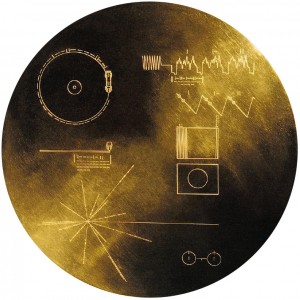
"There were greetings in many different languages on the disc, and my folks thought it would be nice to have a kid represent one."
IEEE Spectrum has an interview with Nick Sagan, the writer and son of astronomer Carl Sagan, about NASA’s Voyager mission, a pair of unmanned space probes launched in 1977. The probes visited Jupiter and Saturn, before heading to the outer solar system. Each carried a golden record, which contained pictures, recordings and a greeting from Earth. Carl chose the record’s contents; Nick, who was then a child, taped a message for the disc on behalf of the planet’s children. An excerpt from the Spectrum piece:
“IEEE Spectrum: What do you remember of the Voyager project?
Nick Sagan: It was very quick and mysterious to me. There were greetings in many different languages on the disc, and my folks thought it would be nice to have a kid represent one. My dad plopped me down in front of a mic in a room at Cornell University, where he taught, and asked me what I would want a visiting extraterrestrial to know. I came up with ‘Hello, from the children of Planet Earth.’
IEEE Spectrum: None of it struck you as odd?
Nick Sagan: These questions were normal in my home. When your dad is an astronomer, there’s a certain focus on this. We’d go out and look at the stars, and there were often astronomers and science fiction writers, like Isaac Asimov and Ray Bradbury, over our house for dinner.
At the time, I was too young to fully understand what Voyager was. But now I’m humbled to be part of it. There’s a possibility that a piece of me will exist long after I’m gone and the Earth ceases to exist. It’s a kind of immortality.”
••••••••••
Tags: Carl Sagan, Nick Sagan
The entire run of satirical magazine Spy, which was to the ’80s and early ’90s as the Daily Show is to this dumb day, is now on Google Books. You can read any of its issues here. From the Google Books introduction of the magazine that Graydon Carter and Kurt Andersen made and which made them:
“Smart. Funny. Fearless. ‘It’s pretty safe to say that Spy was the most influential magazine of the 1980s. It might have remade New York’s cultural landscape; it definitely changed the whole tone of magazine journalism. It was cruel, brilliant, beautifully written and perfectly designed, and feared by all. There’s no magazine I know of that’s so continually referenced, held up as a benchmark, and whose demise is so lamented.’ –Dave Eggers. ‘It’s a piece of garbage’ —Donald Trump.”
••••••••••
Tags: Graydon Carter, Kurt Andersen
From “The Marx Brother,” Rebecca Mead’s smart 2003 profile of superstar Slovenian philosopher Slavoj Zizek:
“Zizek is bearded and bearish, and restricts his wardrobe to proletarian shirts and bluejeans, with an occasional excursion into corduroy. He owns neither jacket nor tie. He speaks six languages, is made uncomfortable by conversational lapses, and avoids them through the ample use of animated monologue. He speaks English at high speed in an accent recalling that of Latka, the character of indeterminate Mitteleuropean origin played by Andy Kaufman on Taxi. If, in the progress of intellectual fashions, Jacques Derrida’s appeal was that he was fascinatingly difficult, and Michel Foucault’s was that he was sexily rigorous, then Zizek’s lies in his accessible absurdity. Unlike earlier academic superstars, however, Zizek has no disciples: there is no School of Zizek, no graduate students writing Zizekian readings of the novels of Henry James or of Star Trek for their theses. Such a thing would be impossible, since one of the characteristics of Zizek’s work is that he applies his critical methodology even to the results of his own critical inquiry, which is another way of saying that he contradicts himself all the time. Eric Santner, who teaches at the University of Chicago and is a dose friend of Zizek, says, ‘One of his fundamental gestures is this: he will present a problem, or a text, then produce the reading that you have come to expect from him, and then he will say, ‘I am tempted to think it is just the opposite.'” To a generation of students raised on Seinfeld, Zizek’s examination of the minutiae of popular culture – his observation, for example, that when he sees a tube of toothpaste advertising ‘thirty per cent free’ he wants to cut off the free third and put it in his pocket – could not be more familiar, and neither could the ironic, self-undermining gesture. As Zizek might put it, he may appear to be a serious leftist intellectual, but is it not the case that he is in fact a comedian?”
••••••••••
Zizek gets philosophical about toilets:
Tags: Rebecca Mead, Slavoj Žižek
As paperbacks become increasingly paperless, libraries have begun loaning e-books. From Singularity Hub: “Amazon recently announced that their new Kindle Lending Library feature will be arriving ‘later this year.’ The Kindle Lending Library will allow over 11,000 public libraries in the US to lend copies of digital books to Kindle users for short periods of time (probably 7-14 days).”
From Joan Didion’s 1966 article, “Some Dreamers of the Golden Dream” (originally entitled, “How Can I Tell Them There’s Nothing Left?”), which profiled Lucille Marie Maxwell Miller, a mother of three who murdered her husband in lovely San Bernardino one sun-drenched day:
Of course she came from somewhere else, came off the prairie, in search of something she had seen in a movie or heard on the radio. For this is a Southern California story. She was born on January 17, 1930, in Winnipeg, Manitoba, the only child of Gordon and Lily Maxwell, both school teachers hers and both dedicated to the Seventh-Day Adventist Church whose members observe the Sabbath on Saturday, believe in an apocalyptic Second Coming, have a strong missionary tendency, and, if they are strict, do not smoke, drink, eat meat, use makeup, or wear jewelry, including wedding rings. By the time Lucille Maxwell enrolled at Walla Walla College in College Place, Washington, the Adventist school where her parents then taught, she was an eighteen-year-old possessed of unremarkable good looks and remarkable high spirits. “Lucille wanted to see the world,’ her father would say in retrospect, ‘and I guess she found out.”
The high spirits did not seem to lend themselves to an extended course of study at Walla Walla College and in the spring of 1949 Licille-Maxwell met and married Gorgon (“Cork”) Miller, a twenty-four-year-old graduate of Walla Walla and of the University of Oregon dental school, then stationed at Fort Lewis as a medical officer. “Maybe you could say it was love at first sight,” Mr. Maxwell recalls. “Before they were ever formally introduced, he sent Lucille a dozen and a half roses with a card that said even if she didn’t come outon a date with him, he hoped she’d find the roses pretty anyway.” The Maxwells remember their daughter as a “radiant” bride.
Unhappy marriages so resemble one another that we do not need to know too much about the course of this one. There may or may not have been trouble on Guam, where Cork and Lucille Miller lived while he finished his Army duty. There may or may not have been problems in the small Oregon town where he first set up private practice. There appears to have been some disappointment-about their move to California: Cork Miller bad told friends that he wanted to become a doctor, that he was unhappy as a dentist and planned to enter the Seventh-Day Adventist College of Medical Evangelists at Loma Linda, a few miles south of San Bernardino. Instead he bought a dental practice in the west end of San Bernardino County, and the family settled there, In a modest house on the kind of street where there are always tricycles and revolving credit and dreams about bigger houses, better streets. That was 1957. By the summer of 1964 they had achieved–the bigger house on the better street and the familiar accouterments of a family on its way up: the $30,000 a year, the three children for the Christmas card, the picture window, the family room, the newspaper photographs that showed “Mrs. Gordon Miller, Ontario Heart Fund Chairman.” They were paying the familiar price for it. And they had reached the familiar season of divorce.•
Joan Didion interviewed in Los Angeles in the 1970s by NBC News.
Tags: Gorgon "Cork" Miller, Joan Didion, Lucille Marie Maxwell Miller
Tags: Andy Warhol, Debbie Harry
Robert Ashley’s avant television opera Perfect Lives (Privacy Rules), composed between 1978-1980 with the help of “Blue” Gene Tyranny, was a surreal, discordant mind-blower when it was first performed, and it’s still really powerful. Video artist John Sanborn is responsible for the amazing visuals. In Robert Ashley, this work is profiled by director Peter Greenaway. Despite being a huge blowhard, Greenaway is capable of greatness, and it’s hard to imagine anyone could have better captured Ashley’s vision.
Tags: "Blue" Gene Tyranny, John Sanborn, Peter Greenaway, Robert Ashley
Even more than a century ago, you had to live a fast life to be thought of as an old-timer by the age of 34. That was sadly the case with a jockey who met his end on Valentine’s Day in 1901. An excerpt from a Brooklyn Daily Eagle story about him:
“Lawrence Urelli, 34 years old, no home, was found dead in a barn owned by Dr. Robert S. Waters, this morning at Avenue U and Van Sicklen Avenue. It appeared that the man had been drinking of late and the doctor had warned him yesterday to stop it. The doctor also told him to keep away from the barn. This morning when he found the lifeless body of Urelli part of the contents of a bottle of wood alcohol which was in the barn had been used, and it is thought Urelli drank it. The Coroner was notified.
Urelli was an old-time jockey, and the Jockey Club will assume all obligations for his funeral.”
•••••••••••
An excerpt from the 2009 GQ article, “Tent City, U.S.A.” an eyewitness account of a latter-day Hooverville in Fresno, California, by George Saunders, the fiercely humanistic short story writer who uses humor the way Twain and Vonnegut did:
“OH, LOTS OF PEOPLE die in here.
The Ho man died. Gladys died. Ferdinand over here died. A guy by the name of Tupac got ran over by a train right here. Richard died, the guy they called the Birdman. He got hit by a train, just back in January, January 31. Because the Mission denied him to stay overnight, he got a blanket from a friend and stayed behind one of the train cars, and lo and behold, they were switching at night, and he was asleep, and evidently they just popped him like a strawberry basically. Really a super guy. But mentally challenged. He would shoot birds, thinking they were there. Very strange fellow. Not with an actual gun, no. Just with his fingers.
There was Edson. He was alcoholic, a good man, but mind you, his son was a professional baseball player. He could have lived differently, but he chose to be out here drinking. There was a lady got hit on the freeway couple months ago. She was crossing the 99, wasn’t paying attention. We’ve had overdoses, stabbings. One homeless guy got burned in his blankets. Some juveniles poured gas on him. We had two people shot here in the past three months. One of them, I was sitting right here when I heard five sharp pops from under the bridge. Then here came this little gal, racing by, shrieking, I told you I’d do it! I told you I’d do it! And she disappeared from Tent City and was never seen again, and the guy she shot in the face died.” (Thanks Longform.)
••••••••••
Tags: George Saunders, Kurt Vonnegut, Mark Twain
Whether he’s a prophet or crackpot (or both), Queens-born futurist Ray Kurzweil is having a moment. Sheerly Avni posted a video at Open Culture of Kurzweil taking questions from Time magazine editor Stephen Koepp.
Tags: Ray Kurzweil, Sheerly Avni, Stephen Koepp
The Objectivist at Madison Square Garden with Phil Donahue in 1979.
Tags: Ayn Rand, Phil Donahue
Singer-songwriter Phoebe Snow just passed away at age 60. Here she is performing with Linda Ronstadt on Saturday Night Live in 1979.
From “Poetry Man“:
“So once again
It’s time to say so long
And so recall the cull of life
You’re going home now”
Tags: Linda Ronstadt, Phoebe Snow

"There was a time in Long Island's cultural history when the whole world looked here for the next big trend in rock 'n' roll." (Image by Malco23.)
In this classic photograph, the Siouxsie and the Banshees frontwoman performs at the legendary Long Island rock club, My Father’s Place. The Roslyn-based live-music venue was once a leading stage for unknown rock artists, from Bruce Springsteen to Meat Loaf to Hall & Oates. It closed its doors in 1987. From a 2000 New York Times piece recalling the cabaret:
“THERE was a time in Long Island’s cultural history when the whole world looked here for the next big trend in rock ‘n’ roll. That was between 1974 and 1980, the heyday of My Father’s Place, a cabaret in Roslyn.
And Michael Epstein, known as Eppy, ran the whole shebang.
Along with My Father’s Place, which opened on Memorial Day in 1971 with a concert by Richie Havens, a confluence of entities created a scene that would influence music for decades to come.
Dance-oriented rock ‘n’ roll, punk, singer-songwriters and New Wave music had become the rage — and it was essential for musicians to come here to perform. My Father’s Place, WLIR-FM and the dance club Malibu in Long Beach were at the center of popular music.
Today, 13 years after My Father’s Place closed, Mr. Epstein still longs for the club. ‘Once it’s in your blood, you never lose that feeling,’ he said.”
•••••••••
Talking Heads at My Father’s Place on May 10, 1978:
Tags: Bruce Springsteen, David Byrne, Eppy, Hall & Oates, Meat Loaf, Michael Epstein, Richie Havens, Siouxsie and the Banshees, Talking Heads
Bachelor number two, from Waco, Texas. He was just 23.
Tags: Steve Martin
From the “1985” section of New York magazine’s fun oral history marking the 25th anniversary of the Beastie Boys’ Licensed to Ill:
“Diamond: Yauch and I got an apartment in Chinatown—apartment might be an overstatement. It was on Chrystie Street when it was still really Chinatown, and it was an entirely sweatshop building. We could play music literally any time of the day or night.
Diamond: I did go [to Vassar] for a semester, and it was hard. I had to go [to my mom] and say, ‘It’s a total waste of your money and my time, because all I want to do is be in this band.’ Rick and Russell were like, ‘You’re gonna make a video for She’s On It.’ And in our minds, we were the biggest deal in the entire world. Our friends might not have agreed. But you know what I mean—all of a sudden we were making a video, and it started to get shown. We were big on the local video channel U68.
Ross: They went up to perform at the Apollo, and Beastie Boys shows at this point were a little haphazard at best. But by the second song, Mike D’s doing the Jerry Lewis, and the whole Apollo Theater is going, ‘Go, white boys! Go, white boys!’ In my head I’m like, ‘My friends are gonna be famous!’
Horovitz: And then the Madonna tour happened. We did like three songs, and then I did the electric boogaloo for a minute, and then we fucked with the audience. They hated us. Kids literally in tears, parents wanting to kill us. It was awesome. They wanted to kick us off the tour, and Madonna was like, ‘These guys are staying, these guys are great.’ We got back to New York, and we were really feeling ourselves. We were crushing our old spots.”
••••••••••
Tags: Beastie Boys, Rick Ross
A 1986 commercial for the grand opening of a new location for the Tower Records chain, which is now out of business. Also gone or going: record stores, VHS tapes, audio cassettes, video stores. Some knew they’d be short-lived.
Such steady “hands.”
The first tablet computer was designed all the way back in 1968, but this 1994 Knight Ridder video envisioning tablets is still amazing. (Thanks Gawker.)

